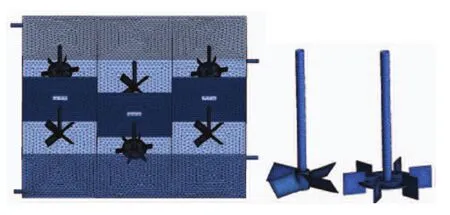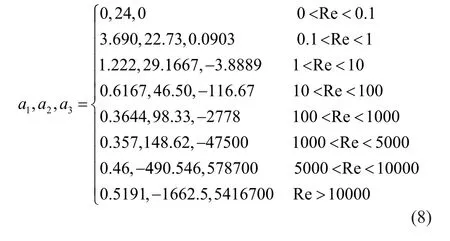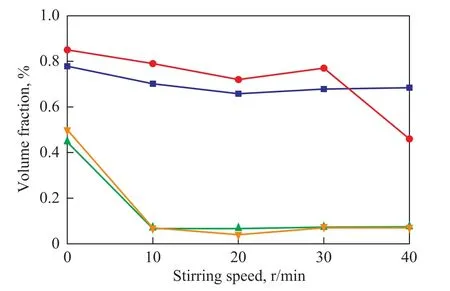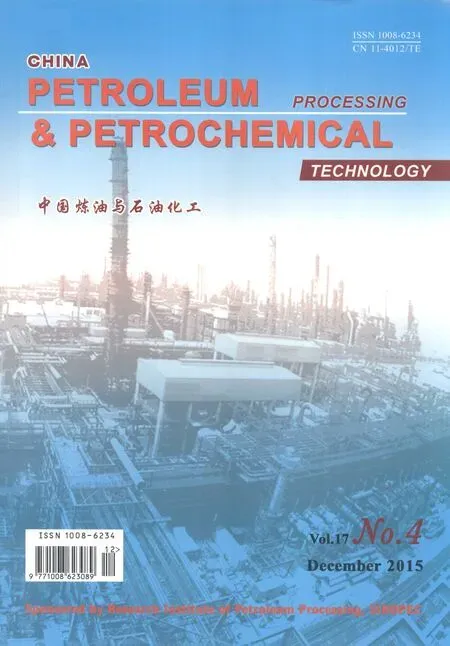Numerical Simulation of Enhanced Oil-Water Separation in a Three-Stage Double-Stirring Extraction Tank
2015-06-22ChaoZhangZimuZhaoQiuyueWangShuchanZhangTinganLiuYan
Lü Chao; Zhang Zimu; Zhao Qiuyue; Wang Shuchan; Zhang Ting’an; Liu Yan
(1. Key Laboratory of Ecological Utilization of Multi-metal Intergrown Ores of Ministry of Education & School of Materials and Metallurgy, Northeastern University; 2. Department of Mathematics, Northeast Petroleum University)
Numerical Simulation of Enhanced Oil-Water Separation in a Three-Stage Double-Stirring Extraction Tank
Lü Chao1,2; Zhang Zimu1; Zhao Qiuyue1; Wang Shuchan1; Zhang Ting’an1; Liu Yan1
(1. Key Laboratory of Ecological Utilization of Multi-metal Intergrown Ores of Ministry of Education & School of Materials and Metallurgy, Northeastern University; 2. Department of Mathematics, Northeast Petroleum University)
Numerical simulation of enhanced fluid flow characteristics in a three-stage double-stirring extraction tank was conducted with the coupling of an Eulerian multiphase flow model and a Morsi-Alexander interphase drag force model. Results show that the addition of a stirring device into the settler can efficiently reduce the volume fraction of out-of-phase impurity in the outlet, and accelerate the settling separation of oil-water mixture. Such addition can also effectively break down the oil-water-wrapped liquid droplets coming from the mixer, inhibit reflux from the outlet, and improve the oil-water separation. The addition of a stirring device induces ignorable power consumption compared with that by the mixer, and can thus facilitate the commercialized promotion of this novel equipment.
three-stage extraction tank; double-stirring; numerical simulation; flow characteristics; power
1 Introduction
Oil-water separation is critical to solvent extraction process of rare earths, which can directly affect the yield and quality of the product[1]. During the extraction of rare earths, high separation efficiency after single extraction is totally unachievable, owing to the limitations in extraction allocation ratio and separation time. The accumulation of extractable components in the oil phase and the reservation of unextractable components in the water phase can be achieved only by repeatedly mixing the oil phase and the liquid-containing water phase in the extract, which will prolong the two-phase contact time. Multiple extraction tanks of this type are connected in a series to create a reverse flow of extracting agent and water-phase liquid, forming a counter-current cascade extraction to improve the extraction efficiency[2-4]. The rare earth separation industry has experienced great advances with the increasing demand from the rare earth market and the gradual innovation of separation technology. As a result, enterprises are urged to adopt more advanced extraction techniques and to improve the production stability and efficiency. Such demand also promotes the application of advanced rare earth extraction technology.
As showed in Figure 1, the double-stirring settlement extraction tank[5-7]works as follows: A stirring device is added into the mixing-settling tank conventionally used in the rare earth industry, and then the oil-water separation during extraction is accelerated through stirring, thereby enhancing the production capability of individual equipment units. This study is based on the existing research on single-stage double-stirring settling extraction tanks. Specifically, on the basis of software FLUENT, the 3D flow field in two-phase rare earth extraction process in a magnified three-stage double-stirring extraction tank is analyzed by numerical simulation. The behaviors (mixing characteristics and separation characteristics) in liquidliquid two-phase movement in the three-stage extraction tank are studied via numerical simulation. The results arevery consistent with experimental results. On this basis, we have analyzed a detailed flow field in the reactor. It is proved that the addition of the stirring device significantly enhances the turbulent intensity and mixing effect in the reactor and can significantly accelerate the oil-water separation.

Figure 1 One-stage double-stirring settlement extraction tank
2 Mathematical Modeling
2.1 Modeling and mesh division
The physical properties of the water and oil phases used in the experiments are presented in Table 1.
The one-stage experimental tank was designed as per a volume ratio of mixing tank: settling tank=1: 1.25. The dimensions of the extraction tank cover a mixer with a volume of 400 mm×400 mm×460 mm, a settler with a volume of 500 mm×400 mm×460 mm, and a clapboard with a 80 mm×40 mm2overflow hole installed between the mixer and the settler, with the liquid level height equating to 420 mm. The stirring paddle (a six-flat-blade disc turbine paddle) of the mixer was installed at the central part and the rotational speed of the paddle is set at 250 r/min. The distance between the stirring paddle (an open-type 45º paddle) and the overflow hole is 200 mm and the paddle’s off-bottom clearance is 140 mm, with the rotational speed of the paddle specified at 20 r/min in the reverse direction.
The physical diagram of three-stage double-stirring extraction tank under magnification is shown in Figure 2a, while the simulated diagram of three-stage double-stirring extraction tank under magnification is presented in Figure 2b. The oil-phase trajectory in the magnified three-stage extraction tank is marked by the white arrowhead, while the water-phase trajectory is represented by the red arrowhead. The extracting agent flows conversely to the water phase, thereby improving the extraction efficiency.
As shown in Figure 3, the geometric model and meshes were plotted on GAMBIT and MIXSIM, which could improve the gridding quality from manual plotting and avoid some complicated setting of boundary conditions.

Figure 3 Schematic grid
The number of grids was controlled within an appropriate range (1.06 million) in order to save much time.
2.2 Model selection
Based on the software FLUENT, the finite volume method was used to solve the discrete equations. The Eulerian models[8-9]were used in numerical simulation of liquid-liquid system in the mixer-settler extraction tank. A dispersed turbulent multiphase flow model was used[10]. The maximum particle diameter in the oil phase was set at 300 µm. A moving reference frame[11-12]was used to process the rotation region of paddles. The fluid flow wasunsteady. The transmission term of control equations was estimated by a velocity-pressure coupled SIMPLE algorithm. The second-order windward format was used as the discrete format. The residual error convergence standard for any item was 10-3. The standard k-ε turbulence model[13-14]was used. The control equation of the standard k-ε equations is expressed as follows:

where μtis the turbulent viscosity.

The model parameters are assigned as follows:

The interphase drag force used in this study is a Morsi-Alexander model[15]

where the drag force is expressed as follows:

in which

2.3 Setting of boundary conditions
When the flow rates are known, the time-averaged velocity at the inlet sectional normal direction, the volume fractions of oil phase and water phase, and the corresponding turbulence parameters can be estimated. Specifically, the inlet oil-phase velocity is 0.884 6 m/s, and the inlet waterphase velocity is 0.442 3 m/s, while the initial volume fraction ratio of oil-to-water is 2:1. The outlet was set as free outflow. The Flow Rate Weightings of oil phase and water phase at the outlet were set at 0.667 and 0.333, respectively, which guaranteed the mass conservation in the mixing extraction tank and the oil-water volume fraction ratio was stabilized at 2:1. The boundary conditions are set as follows: The non-slip walls had a default roughness of 0.5, and the boundary turbulence was treated by a standard wall function.
3 Results and Discussion
3.1 Analysis of outlet volume fraction changes
Figure 4 shows the comparison between experimental results and numerical simulation outcome. Clearly, the volume fractions of out-of-phase at the outlet (volume fractions of oil-phase impurity at the water-phase outlet; volume fractions of water-phase impurity at the oil-phase outlet) are very consistent between the two types of tests, with errors equating to less than 10%. In particular, the volume fraction (0.46%) of water-phase impurity at the oil-phase outlet at a stirring speed of 40 r/min is very low, probably because of measurement errors during experiments. These results can confirm that the model selection and boundary condition setting in numerical simulation are appropriate. Thus, the numerical simulation is able to characterize the oil-water mixing and separation in the high-efficiency three-stage double-stirring settling extraction tank. The addition of a stirrer into the settler signif icantly reduces the volume fraction of out-of-phase impurity at the outlet, and accelerates the oil-water separation.

Figure 4 Experimental results of outlet out-of-phase volume fraction at different rotation rates, and comparison with simulated results■—simulation results of volune fraction of water;●—experiment results of volune fraction of water;▲—simulation results of volume fraction of oil;▼—experiment results of voume fraction of oil
As shown in Figure 3, at a stirring speed of 20 r/min, the volume fraction of out-of-phase impurity at the two-phase outlet is minimized. Thus, during numerical simulation, a stirring speed of 20 r/min is selected as the appropriate stirring intensity in the settler in the subsequent experiments.
As shown in Figure 5, the stirring effect in the mixer is very significant, indicating to the complete mixing of oil-water phases. The oil-water two-phase mixing layer at different paddle shaft sections is quite wide when no stirring is applied in the settler (Figure 5a). The mixing layer shows evident lamination, and the settling process is mainly affected by gravity sedimentation. With the addition of stirring, the two-phase mixing layer at different paddle shaft sections is very narrow (Figure 5b). The water-oil mixing near the stirring paddle is broken by the stirring, so the two-phase wrapping is smashed. The oilwater separation efficiency is significantly improved by the joint action of stirring and gravitational settling.

Figure 5 Volume fraction graphs: (a) without stirring, and (b) with stirring
3.2 Analysis of flow state
As shown in Figure 6, the trajectory of particles covers the whole mixer, which can verify that the stirring has efficient two-phase mixing effect and achieves complete mixing. The addition of stirring by the paddle can promote the extracting agent and liquid mixing in practice. The liquid after mixing, or namely the oil-water mixed liquid, enters the settler through the overflow hole. Under the stirring action by the stirring paddle in the settler, the liquid droplets formed from the oil-water inter-wrapping can accelerate the agglomeration and floating of oil phase, and also the agglomeration and sedimentation of water-phase droplets. The oil-phase and water-phase form small vortices in the upper and lower parts of the stirring paddle, respectively. When the volume of the settler can be reduced, prolonging the oil-water contact time is favorable to the two-phase separation.
As shown in Figure 7a, after 0.5 s, the stirring velocity is concentrated around the blades, but is non-uniformly distributed in the whole mixer. The trajectory shows the stirring in the whole tank is good, which is favorable to the two-phase mixing. As shown in Figure 7b, after 1 s, the stirring force keeps the oil-phase and water-phase in motion. The large-velocity areas in the mixer drift near the walls, dividing the liquid into upper and lower parts, which form two axial small-radius circumfluents on the section. As shown in Figure 7c, after 2 s, the stirring is increasingly complete. The axial circumfluents extend to the top and bottom, and their radii gradually increase with growing liquid flow vector. Under complete stirring, theliquid mainly experiences a coupling movement of radial rotating flow and axial circulation. Thus, the mixing at axial and radial directions is very complete. As shown in Figure 7d, after 3 s, when vortex is formed, the water-oil two-phase flow field is basically stabilized.

Figure 6 Trajectory of particles

Figure 7 Velocity graphs and isoline graphs in the mixer: (a) after 0.5 s; (b) after 1 s; (c) after 2 s; and (d) at 3 s
As shown in Figure 8a, in the upper part of the nephograms of in-settler velocity, the oil-water separation is dominated by gravitational settling, while that in the middle part shows the velocity reflux to the mixer. The main reasons are that the high-speed stirring in the mixer accelerates the flow of two-phase mixing scatter band. Upon flowing to the outlet, the flow impacts against the wall to form reflux. The reflux causes chaos in the lower part of the water-phase velocity field, which is unfavorable to oil-water separation. As shown in Figure 8b, the rotation at the direction of the stirring paddle in the novel high-efficiency settling extraction tank effectively inhibits the reflux. The centrifugal force caused by the stirring rotation drives the water-phase liquid drops to deviate from the direction of the stirring paddle, or namely toward the outlet, which greatly improves the separation efficiency.

Figure 8 Velocity graphs and isograms in the settler: (a) without stirring, and (b) with stirring
3.3 Power analysis
As shown in Table 2, the stirring paddle in the mixer produces a power of 106.3751 W. In comparison, when the rotation rate is increased from 10 r/min to 40 r/min, the power needed by the settler is relatively smaller, about 1/100 of that needed by the mixer. Thus, the power consumption due to addition of a stirrer into the settler can be ignored. In other words, the additional excess energy consumption can largely improve the oil-water separation efficiency, which is significant for the promotion of this novel extraction tank in the industry.

Table 2 Power at different speed
4 Conclusions
The mixing effect, settling effect, and stirring power of a three-stage double-stirring settling extraction tank were studied via numerical simulation with the software FLUENT.
1) Regarding the volume fraction of out-of-phase impurity at the outlet, the addition of a stirring device into the settler can effectively improve the oil-water separation effect.
2) Analysis of flow field shows that at a stirring speed of 200 r/min the oil-water mixing is very complete, which is favorable to the complete contact between the extracting agent and the liquid in practice. The addition of a stirring device into the settler can break down the oil-waterwrapped droplets coming from the mixer, and efficiently inhibit the reflux from the outlet, thus accelerating the two-phase settling and separation.
3) Analysis of power simulation shows that the power consumption due to the addition of a stirrer into the settler can be ignored in comparison with that in the mixer. This study theoretically underlies the promotion of multistage double-stirring extraction tanks in the industry.
Acknowledgements:This research was financially supported by the National 863 Plan (2010AA03A405, and 2012AA062303), the National 973 Plan (2012CBA01205), the National Natural Science Foundation of China (U1202274, 51204040), the National Science and Technology Support Program (2012BAE01B02) and the Fundamental Research Funds for the Central Universities (N130702001 and N130607001).
[1] Wang Shuchan, Zhang Ting’an, Zhang Zimu, et al. Effect of stirring on oil-water separation in rare earth mixer-settler[J]. China Petroleum Processing and Petrochemical Technology,2014, 16(3): 99-103
[2] Chai Tianyou, Yang Hui. Situation and Developing trend of rare-earth countercurrent extraction processes control[J]. Journal of the Chinese Rare Earth Society, 2004, 22(4): 427-433
[3] Nishizawa Hideyuki, Tahara Kayoko, Shinobu Motegi, et al. True moving bed chromatography: solid–liquid multi-stage counter-current extraction[J]. Journal of Chromatography A, 1999, 849(1): 61-69
[4] Zhou Jing, Ye Feng. Simulation and verification of string class experiment method of current contact extraction by Aspen Plus[J]. Computers and Applied Chemistry, 2008, 25(4): 441-444 (in Chinese)
[5] Wang Shuchan, Zhang Ting’an, Zhao Qiuyue, et al. Experimental study on aqueous phase entrainment in a mixersettler with double stirring model[J]. China Petroleum Processing and Petrochemical Technology, 2013, 15(2): 59-62
[6] Lü Chao, Zhang Zimu, Zhao Qiuyue, et al. Numerical simulation on mixing time of high efficient clarification and extraction tank with double stirring[J]. Journal of Northeastern University: Natural Science, 2014, 35(6): 809-812 (in Chinese)
[7] Lü Chao, Zhang Zimu, Zhao Qiuyue, et al. Numerical simulation on fluid flow characteristics of the settler in efficient clarification and extraction tank with double stirring[J]. Journal of North-eastern University: Natural Science, 2014, 35(11): 1570-1573 (in Chinese)
[8] Zhou Hua. Numerical analysis of the 3-D flow field of pressure atomizers with V-shaped cut at orifice[J]. Journal of Hydrodynamics, 2011, 23(2): 187-192
[9] Belhadef A, Vallet A, Amielh M, et al. Pressure-swirl atomization: Modeling and experimental approaches[J]. International Journal of Multiphase Flow, 2012, 39: 13-20
[10] Kaushal D R, Kumar A, Tomita Yuji, et al. Flow of monodispersed particles through horizontal bend[J]. International Journal of Multiphase Flow, 2013, 52: 71-91
[11] Craig K J, Nieuwoudt M N, Niemand L J. CFD simulation of anaerobic digester with variable sewage sludge rheology[J]. Water Research, 2013, 47(13): 4485-4497
[12] Zhang Tao, Yang Chenjun, Song Baowei. Investigations on the numerical simulation method for the open-water performance of contra-rotating propellers based on the MRF model[J]. Journal of Ship Mechanics, 2010, 14(8): 847-853 (in Chinese)
[13] El-Amin M, Sun S, Heidemann W, et al. Analysis of a turbulent buoyant confined jet modeled using realizable k–ε model[J]. Heat and Mass Transfer, 2010, 46(8): 943-947
[14] Das Shyam S, Sahu Akshaya K, Padmakumar G, et al. CFD analysis of thermal stratification and sensitivity study of model parameters for k–ε model in a cylindrical hot plenum[J]. Nuclear Engineering and Design, 2012, 250: 417-435
[15] Mori S A, Alexander A J. An investigation of particle trajectories in two-phase flow systems[J]. Journal of Fluid Mechanics, 1972, 55(2): 193-208
The Project “Development of Package Technology for Producing Biodiesel from Microalgae” Passed SINOPEC’s Technical Assessment
On August 7, 2015 the project “Development of package technology for producing biodiesel from microalgae”, which was jointly undertaken by the SINOPEC Research Institute of Petroleum Processing (RIPP), the Fushun Research Institute of Petroleum and Petrochemicals (FRIPP), and relevant institutions subordinated to Chinese Academy of Sciences (CAS), has passed the technical assessment organized by the Science and Technology Division of the Sinopec Corp. The Specialist Assessment Committee was comprised of the leaders and experts from the Science and Technology Division of the Sinopec Corp., CAS, the SINOPEC Shanghai Engineering Company, the SINOPEC Shijiazhuang Refining and Chemical Branch Company, the Beijing Normal University, and the Wuhan University.
The meeting attendees after having listened to the work reports made by the project performers have engaged in serious assessment and discussions, while unanimously recognizing that this project has accomplished the survey, screening, establishment of a microalgae data bank and genetic breeding, coupled with development of the technique for massive culture of oil-producing microalgae in open pool and the technique for closed-type culture of oil-producing microalgae to form a package technology for producing biodiesel from microalgae, which will lay a solid foundation for the forthcoming exploratory application of microalgae.
date: 2015-07-20; Accepted date: 2015-08-02.
Dr. Zhang Ting’an, Telephone: +86-24-83690459; E-mail: zta2000@163.net.
杂志排行
中国炼油与石油化工的其它文章
- Design and Control of Self-Heat Recuperative Distillation Process for Separation of Close-Boiling Mixtures: n-Butanol and iso-Butanol
- Computational Fluid Dynamics Simulation of Liquid-Phase FCC Diesel Hydrotreating in Tubular Reactor
- Promotional Effect of CoO(OH) on Selective Hydrogenation of Maleic Anhydride to γ-Butyrolactone over Supported Ruthenium Catalyst
- Microbial Characterization of Denitrifying Sulfide Removal Sludge Using High-Throughput Amplicon Sequencing Method
- Hydrothermal Liquefaction of Wheat Straw in Sub-critical Water/Ethanol with Ionic Liquid for Bio-oil Production
- Quantitative Analysis Using Fourier Transform Ion Cyclotron Resonance Mass Spectrometry and Correlation between Mass Spectrometry Data and Sulfur Content of Crude Oils
